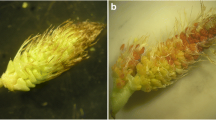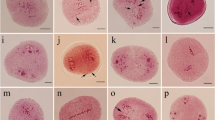Abstract
The objective of this work was to determine the type of inheritance (disomic/polysomic) in tetraploid (2n=4x=40) Paspalum notatum and investigate the transmission pattern of the chromosome region associated with apospory. An F1 family segregating for the reproductive mode (aposporous vs non-aposporous) was generated by crossing a tetraploid sexual plant as female parent with an apomictic individual as pollen donor. Pollen mother cells from both parental plants were examined to ascertain chromosome-pairing behavior at meiosis. The high rate of quadrivalent chromosome associations indicated an autotetraploid origin of the species, although bivalent pairing and occasional univalents were detected. The observation of a lagging bivalent, a bridge of chromatin, or two aligned laggards in the aposporous parent suggested a chromosome inversion in this strain. Segregation ratios of AFLP markers and the proportion of linkages in repulsion versus coupling phase denoted tetrasomic inheritance, but markers displaying disomic ratios were also observed. Preferential chromosome pairing (disomic inheritance) in the chromosome segment related to apospory was detected. The possible relationship between a chromosome rearrangement and the inheritance of apospory is discussed.


Similar content being viewed by others
References
Al-Janabi SM, Honeycutt RJ, Mc Clelland M, Sobral BW (1993) A genetic linkage map of Saccharum spontaneum L. SES 208. Genetics 134:1249–1260
Brown WV (1972) Inversions. In: Brown WV (ed) Texbook of cytogenetics. Mosby, Saint Louis, Mo., USA, pp 196–206
Burton GW (1946) Bahiagrass types. J Am Soc Agron 38:273–281
Burton GW (1948) The method of reproduction of common bahiagrass, Paspalum notatum. J Am Soc Agron 40:443–452
Da Silva JAG, Sorrells ME, Burnquist WL, Tanskley SD (1993) RFLP linkage map and genome analysis of Saccharum spontaneum. Genome 36:782–791
Forbes I, Burton GW (1961) Cytology of diploids, natural and induced tetraploids, and intraspecific hybrids of bahiagrass, Paspalum notatum Flügge. Crop Sci 1:402–406
Goel S, Chen Z, Conner JA, Akiyama Y, Hanna WW, Ozias-Akins P (2003) Delineation by fluorescence in situ hybridization of a single hemizygous chromosomal region associated with aposporous embryo sac formation in Pennisetum squamulatum and Cenchrus ciliaris. Genetics 163:1069–1082
Gould FW (1966) Chromosome numbers of some Mexican grasses. Can J Bot 44:1683–1696
Gustine DL, Sherwood RT, Huff DR (1997) Apospory-linked molecular markers in buffelgrass. Crop Sci 37:947–951
Jessup RW, Burson BL, Burow GB, Wang YW, Chang C, Li Z, Paterson AH, Hussey MA (2002) Disomic inheritance, suppressed recombination and allelic interactions govern apospory in buffelgrass as revealed by genome mapping. Crop Sci 42:1688–1694
Kosambi DD (1944) The estimation of map distance from recombination values. Ann Eugen 12:172–175
Lander ES, Green P, Abrahamson J, Barlow A, Daly MJ, Lincoln SE, Newburg L (1987) MAPMAKER: an interactive computer package for constructing primary genetic linkage maps of experimental and natural populations. Genomics 1:174–181
Martínez EJ, Urbani MH, Quarin CL, Ortiz JPA (2001) Inheritance of apospory in bahiagrass, Paspalum notatum. Hereditas 135:19–25
Martínez EJ, Hopp EH, Stein J, Ortiz JPA, Quarin CL (2003) Genetic characterization of apospory in tetraploid Paspalum notatum based on the identification of linked molecular markers. Mol Breed 12:319–327
Ortiz JPA, Pessino SC, Leblanc O, Hayward MD, Quarin CL (1997) Genetic fingerprinting for determining the mode of reproduction in Paspalum notatum, a subtropical apomictic forage grass. Theor Appl Genet 95:850–856
Ortiz JPA, Pessino SC, Bhat V, Hayward MD, Quarin CL (2001) A genetic linkage map of diploid Paspalum notatum. Crop Sci 41:823–830
Ozias-Akins P, Roche D, Hanna WW (1998) Tight clustering and hemizygosity of apomixis-linked molecular markers in Pennisetum squamulatum implies genetic control of apospory by divergent locus that may have no allelic form in sexual gentypes. Proc Natl Acad Sci USA 95:5127–5132
Pessino SC, Evans C, Ortiz JPA, Armstead I, do Valle CB and Hayward MD (1998) A genetic map of the apospory-region in Brachiaria hybrids: identification of two markers closely associated with the trait. Hereditas 128:153–158
Pupilli F, Caceres ME, Quarin CL, Arcioni S (1997) Segregation analysis of RFLP markers reveals a tetrasomic inheritance in apomictic Paspalum simplex. Genome 40:822–828
Qu L, Hancock JF (1995) Nature of 2n gamete formation and mode of inheritance in interspecific hybrids of diploid Vaccinium darrowiand tetraploid V. corymbosum. Theor Appl Genet 91:1309–1315
Qu L, Hancock JF (2001) Detecting and mapping repulsion-phase linkage in polyploids with polysomic inheritance. Theor Appl Genet 103:136–143
Quarin CL, Burson BL, Burton GW (1984) Cytology of intra- and interspecific hybrids between two cytotypes of P. notatum and P. Cromyorrhyzon. Bot Gaz 145:420–426
Quarin CL, Urbani MH, Blount AR, Martínez EJ, Hack CM, Burton GW, Quesenberry KH (2003) Registration of Q4188 and Q4205, sexual tetraploid germplasm lines of bahiagrass. Crop Sci 43:745–746
Ritter E, Gebhardt C, Salamini F (1990) Estimation of recombination frequencies and construction of RFLP linkage maps in plants from crosses between heterozygous parents. Genetics 125:645–654
Sorrells ME (1992) Development and application of RFLPs in polyploids. Crop Sci 32:1086–1091
Tischler CR, Burson BL (1995) Evaluating different bahiagrass cytotypes for heat tolerance and leaf epicutelar wax content. Euphytica 84:229–235
Wu KK, Burnquist W, Sorrells ME, Tew TL, Moore PH, Tanksley SD (1992) The detection and estimation of linkage in polyploids using single-dose restriction fragments. Theor Appl Genet 83:294–300
Acknowledgments
This study was financed by Agencia Nacional de Promoción Científica y Tecnológica (ANPCyT), projects nos. 6134 and 6367, Argentina; Consejo Nacional de Investigaciones Científicas y Técnicas (CONICET), Argentina; and the International Foundation for Science (IFS), grant no. C/2870–2, Sweden. J. Stein and E.J. Martínez received fellowships from ANPCyT and CONICET, respectively. S.C. Pessino, C.L. Quarin, and J.P.A. Ortiz are research staff members of CONICET.
Author information
Authors and Affiliations
Corresponding author
Additional information
Communicated by H.C. Becker
Rights and permissions
About this article
Cite this article
Stein, J., Quarin, C.L., Martínez, E.J. et al. Tetraploid races of Paspalum notatum show polysomic inheritance and preferential chromosome pairing around the apospory-controlling locus. Theor Appl Genet 109, 186–191 (2004). https://doi.org/10.1007/s00122-004-1614-z
Received:
Accepted:
Published:
Issue Date:
DOI: https://doi.org/10.1007/s00122-004-1614-z




